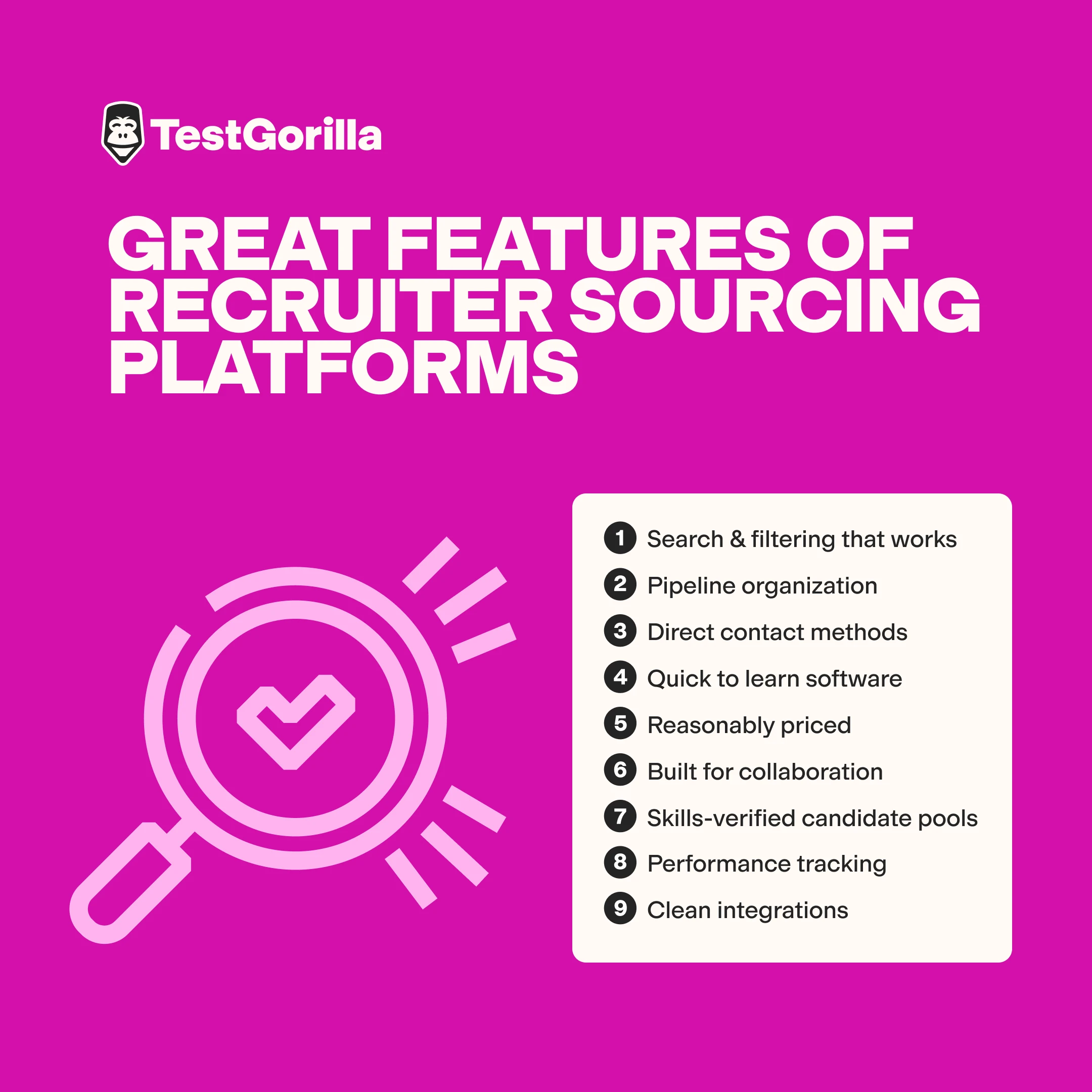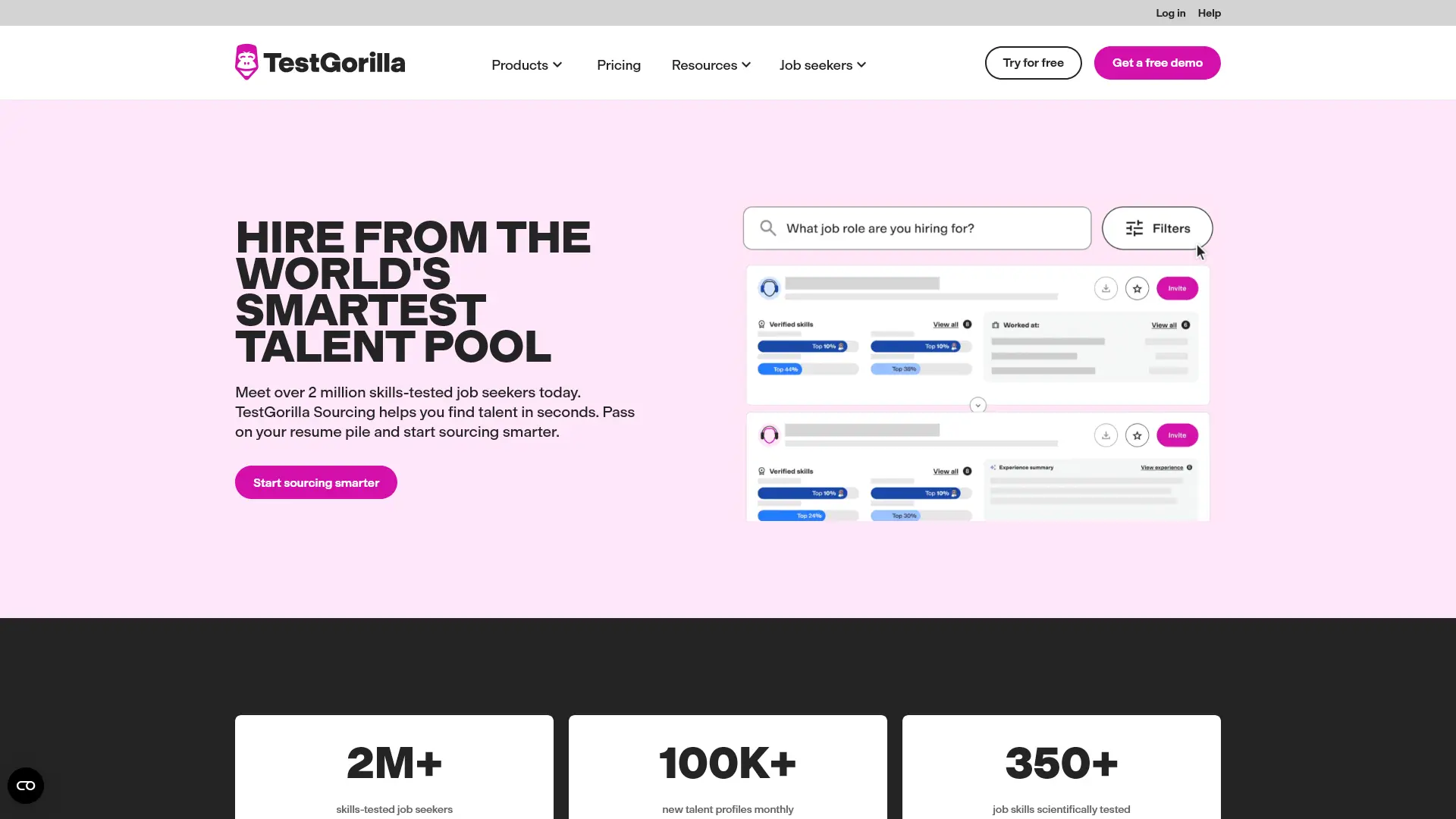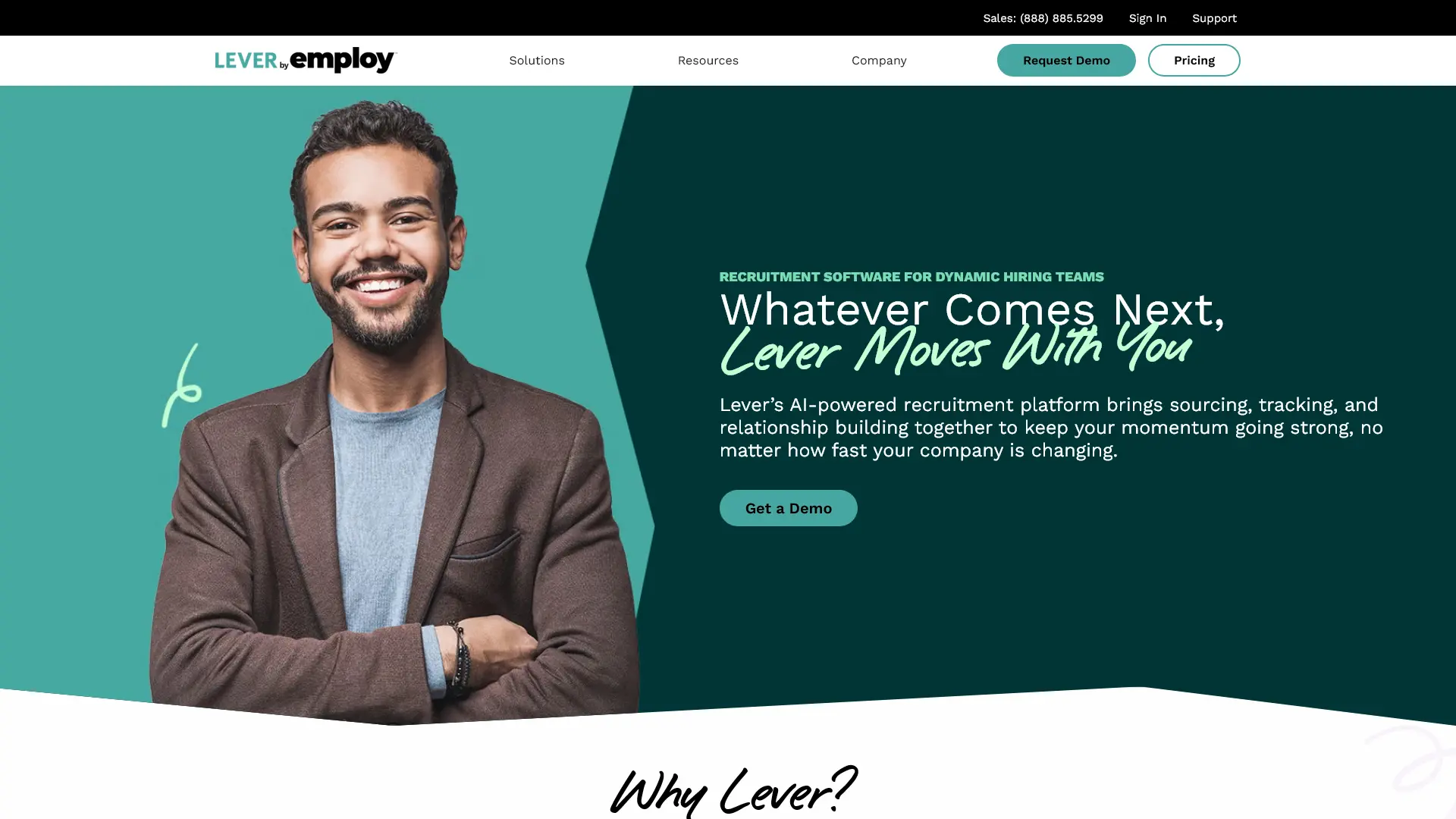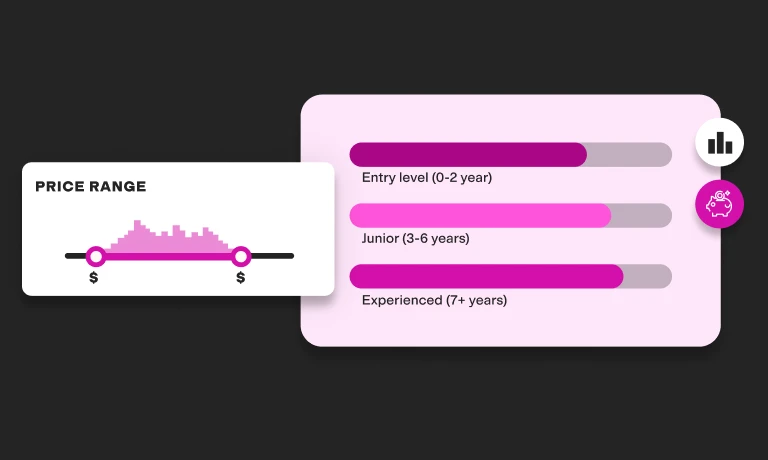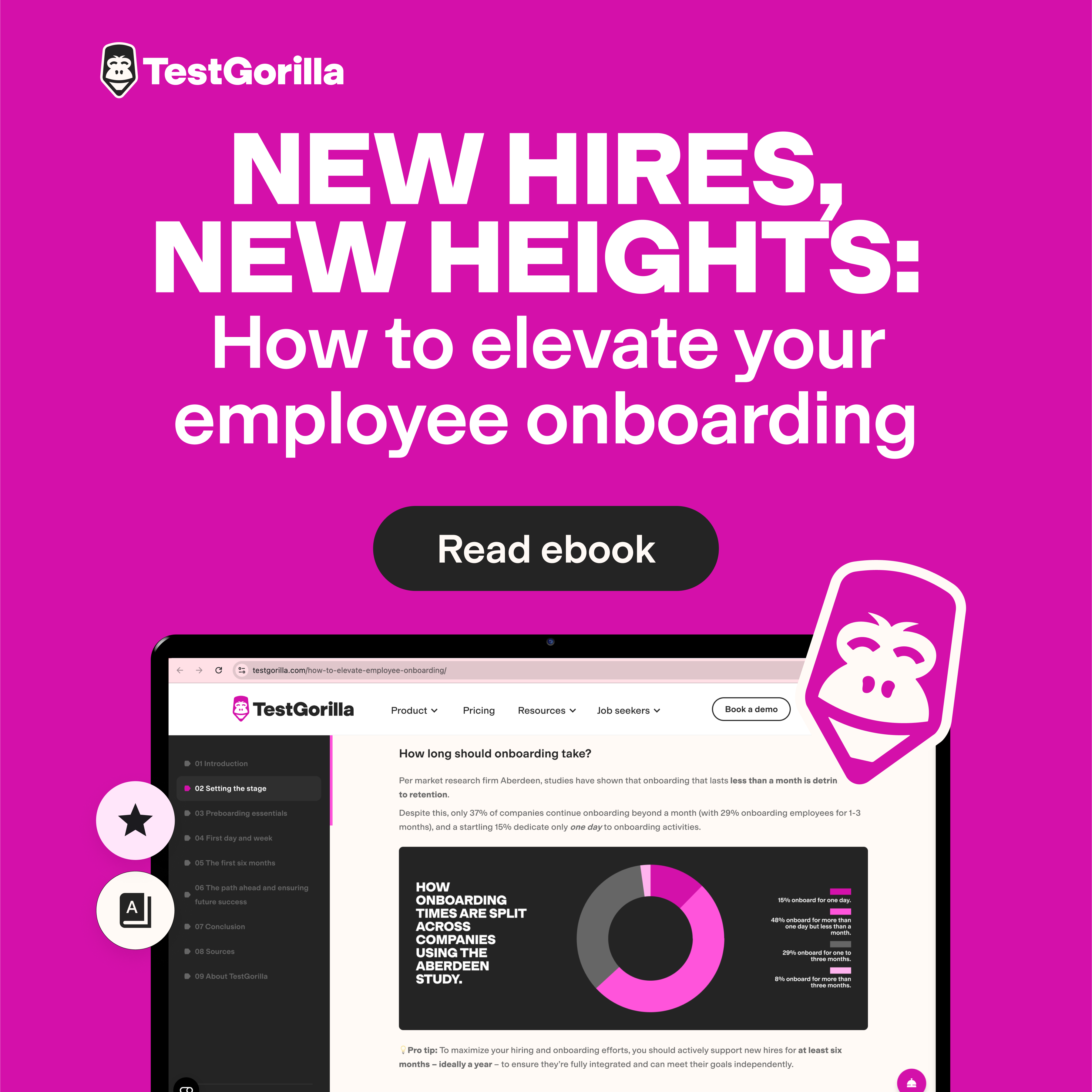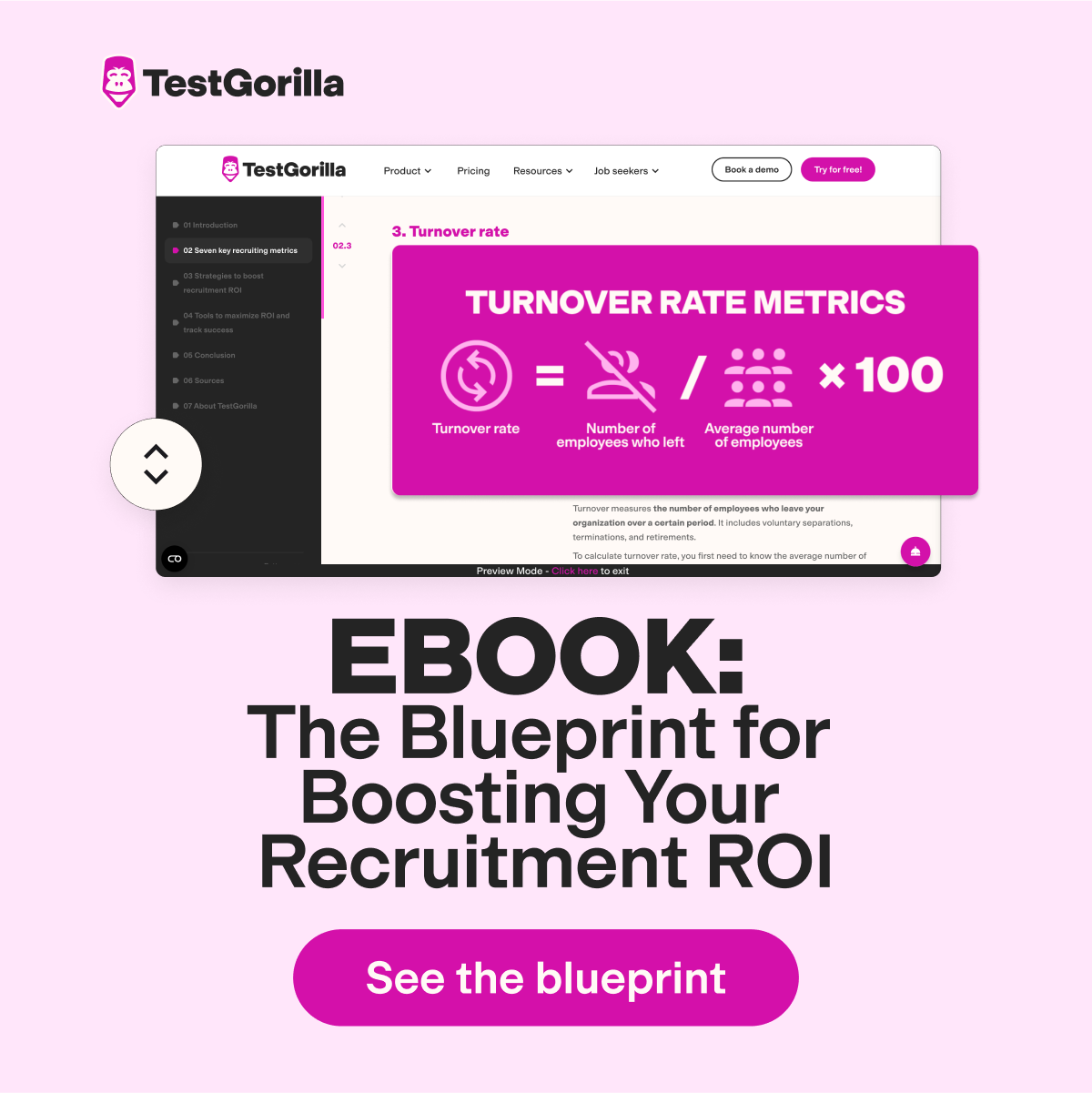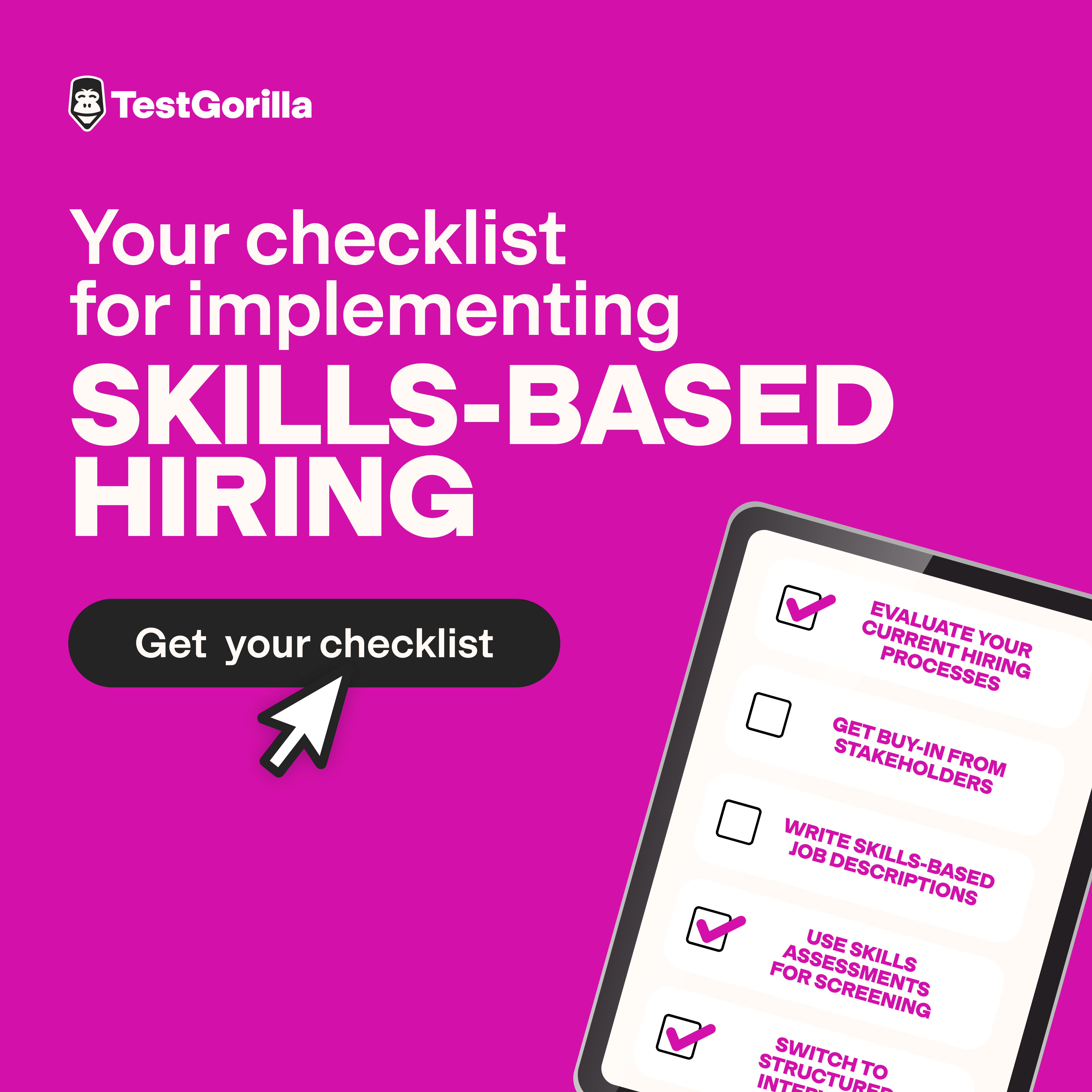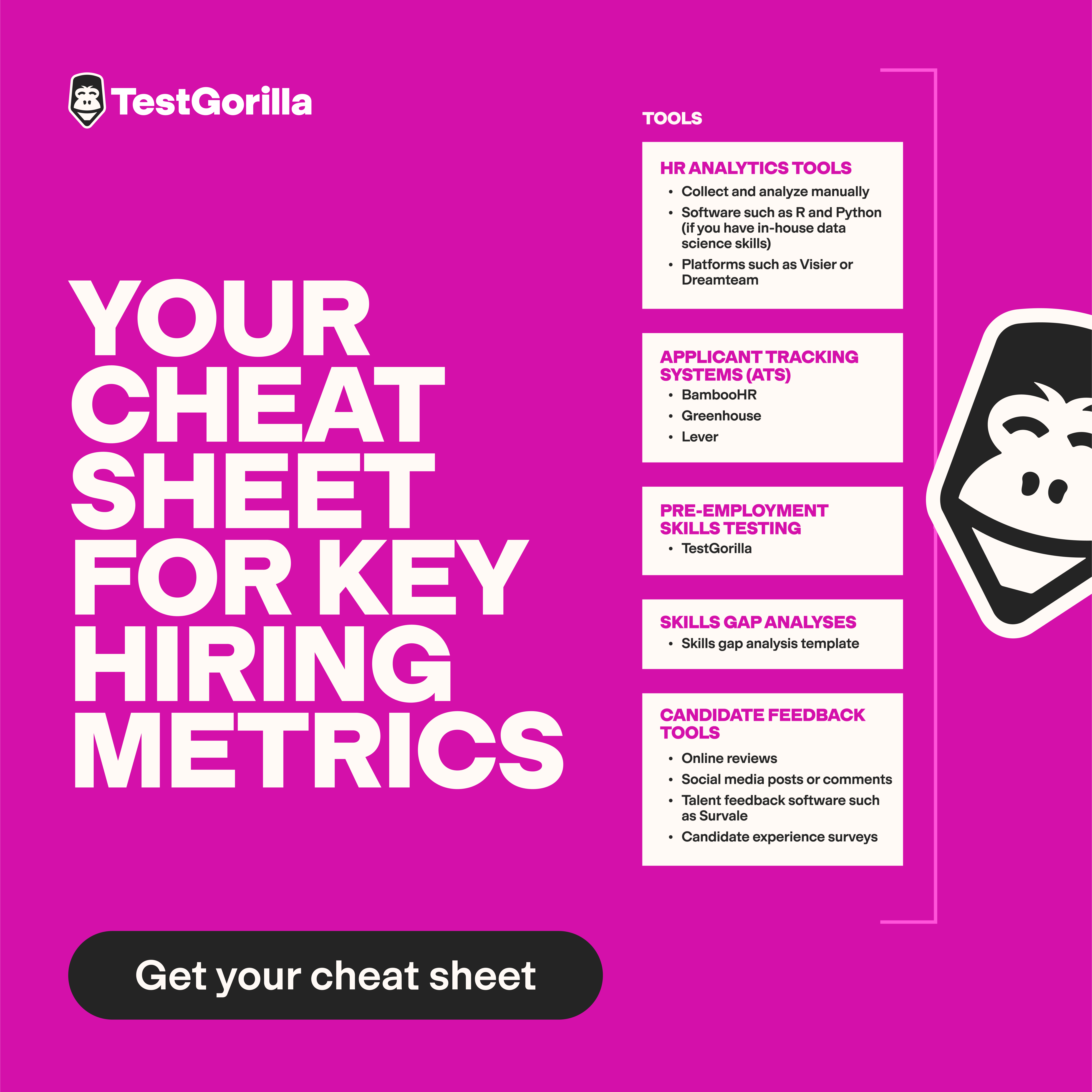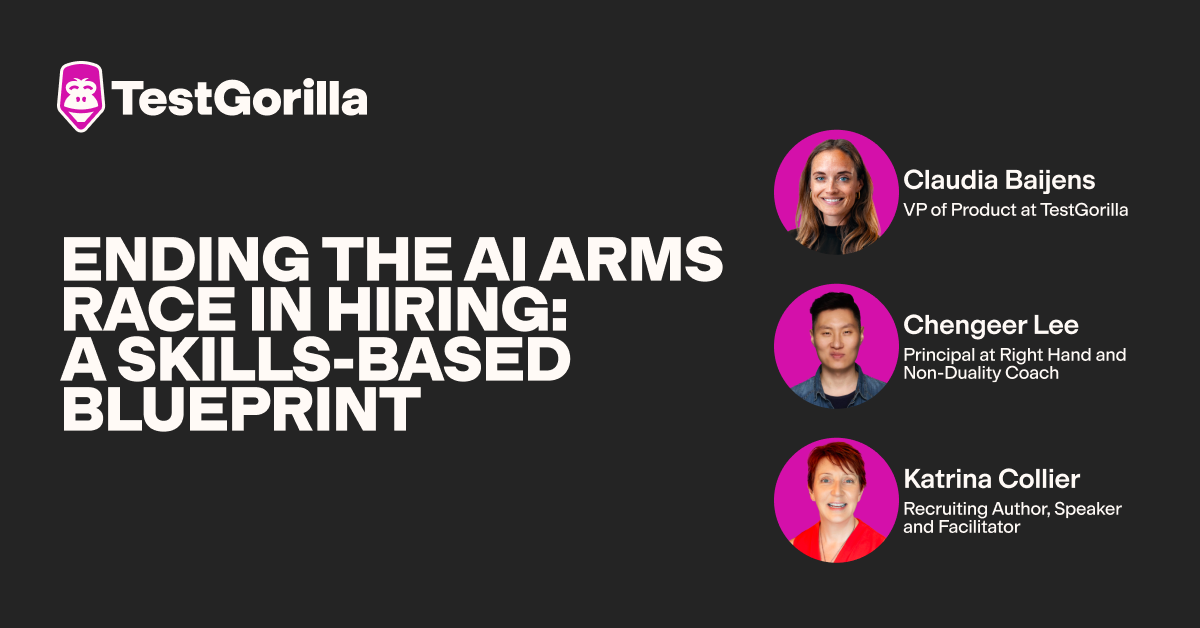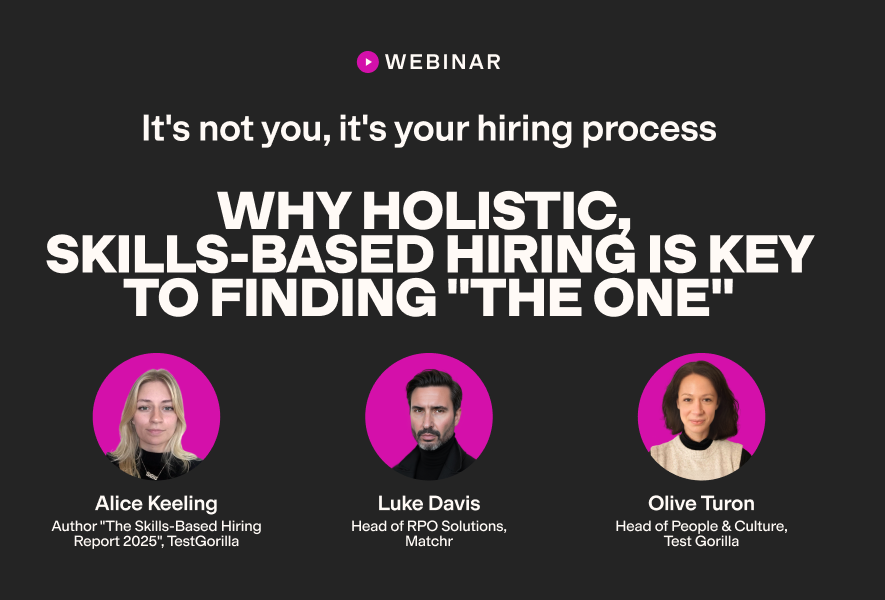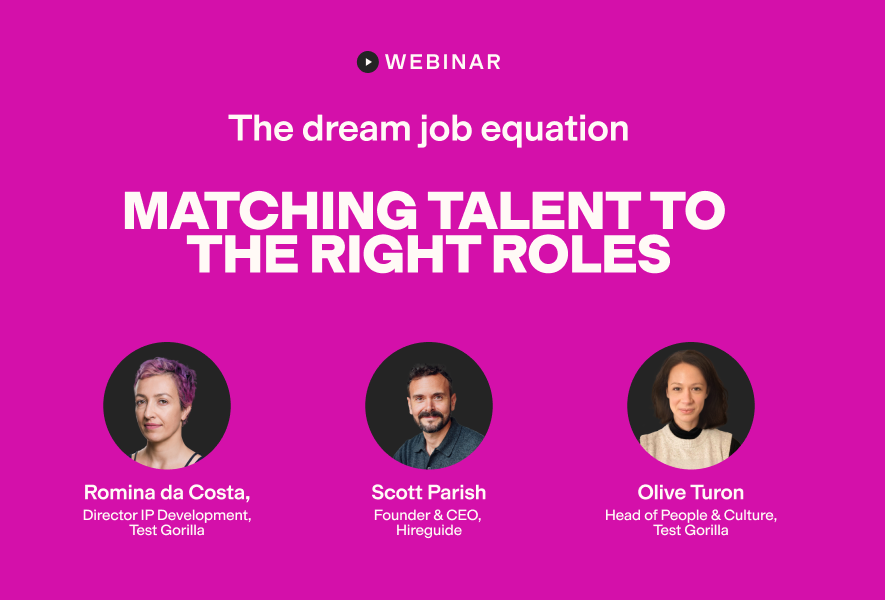Sourcing candidates can feel like starting from scratch for every new role. You post a job, get flooded with resumes, and waste hours screening unqualified candidates. It’s a frustrating cycle that leaves your pipeline empty when you need it full.
Recruiter sourcing tools help you break this cycle by building a proactive pipeline of qualified talent. You can find candidates, organize them, and even verify their skills before the first interview.
In this article, I share the top sourcing tools for building stronger candidate pipelines.
How I chose the 5 best recruiter sourcing platforms
A good sourcing tool should do more than just pull up names. It needs to help you build an active, organized, and qualified pipeline.
To find the best ones, I looked past the marketing buzz and focused on platforms that actually deliver on their promises.
First, I looked for the must-have features to source talent effectively:
Search and filtering that works, helping you narrow thousands of profiles down to the relevant ones.
Pipeline organization that lets you track who you’ve contacted, who responded, and who to follow up with.
Direct contact methods so you can reach candidates without hunting down email addresses.
I also made sure the software is:
Quick to learn, so your team can start using it this week.
Priced reasonably, whether you’re a solo recruiter or part of a large talent acquisition department.
Built for collaboration, so everyone can share notes and avoid duplicate outreach.
Finally, I checked for features that make recruiter sourcing tools great:
Skills-verified candidate pools that show you proof of ability before reaching out.
Performance tracking, so you know which messages work and which sources deliver quality candidates.
Clean integrations that streamline your workflows by connecting smoothly with other tools.
After my search, I picked my top five tools that will help you find the right people, not just more people.
The 5 best recruiter sourcing tools
1. TestGorilla
Best all-in-one recruiter sourcing and assessment tool Platforms: Web, iOS, Android
Why I chose TestGorilla: I chose TestGorilla because it directly addresses what I see as the biggest pain point for recruiters: wasted time screening unqualified candidates. TestGorilla Sourcing provides a database of more than two million job seekers who have already completed skills tests through TestGorilla Assessments.
Search candidates who’ve already proven their skills
For me, the biggest difference with TestGorilla is that it helps you build your pipeline on evidence, not hollow keywords.
If I’m searching for a content writer, AI matching uses context to find candidates with exact and related skills. I can instantly filter for those who scored in the top 20% on TestGorilla’s SEO Copywriting test and see actual test results.
Instead of filling your pipeline with maybes, you’re adding candidates who’ve already demonstrated their abilities. More than 100,000 new candidates join monthly, so you know you’re tapping into a fresh, active pool, too.
Hire on proof, not preconceptions
Likewise, TestGorilla helps you build a fairer pipeline right from the start. Instead of names or photos on candidate profiles, you see job titles, locations, desired salaries, skills, and test scores. This helps you move away from biased assumptions and toward real proof of potential.
Even when it comes to culture add or motivation, TestGorilla keeps things objective. Those traits are often judged on gut feeling, leading to hiring decisions made on affinity bias rather than actual fit. But here, they’re assessed objectively, so you never have to rely solely on instinct.
You also get clear reports that make it easy to compare candidates using the same criteria. This is just another way TestGorilla helps you keep hiring decisions consistent, transparent, and fair.
Invite them for a chat or take a new assessment
Once you’ve found strong matches, you can contact them directly through the platform, via customizable invitation emails.
TestGorilla’s transparent pricing and credit system make it easy to choose how you engage candidates: invite them straight to an interview (for one credit), or send a custom skills assessment to dig further into their capabilities (for three credits). You combine up to five of our 350+ expert-created tests to create an assessment, which can include your own questions or AI video interviews.
Plans start at $96 per month and include 250 credits, which you can top up when you want.
Key features
Database of 2M+ candidates with verified test scores
Filters to search talent by specific skills tests taken
AI matching to identify candidates with related skills
Email tools to engage candidates directly through the platform
Custom assessments to evaluate role-specific abilities
Candidate reports to compare talent side-by-side using objective data
Pros & cons
Verifies every candidate through skills testing
Combines sourcing and assessment in one workflow
Adds new candidates constantly (100k+ joining monthly)
Offers transparent pricing with no surprise fees
Has a smaller pool than LinkedIn’s network
Pricing
Free plan available (TestGorilla Assessments only)
Paid plans start at $96/month (includes 250 credits)
2. LinkedIn Recruiter
Good for searching the largest professional network
Why I chose LinkedIn Recruiter: I ranked LinkedIn Recruiter next because it lets HR teams tap into a massive professional network and send direct messages to people they want to recruit. It’s separate from the free LinkedIn platform and offers access to more than a billion profiles.
While there’s a Recruiter Lite option, it’s very limited in terms of candidate recommendations and filters, so I’d recommend only the full Recruiter version. With it, companies can use 40+ search filters, access the entire LinkedIn talent pool, and see who’s most likely to respond based on profile activity or an “open to work” status.
After finding candidates, HR teams can use LinkedIn InMail to message anyone on the platform, even if they’re not connected. There’s also an AI tool for writing templated messages based on someone’s profile, and “team folders” that recruiters can use to view and share candidates.
The main drawbacks of LinkedIn Recruiter are cost and data accuracy. Pricing is by quote only, but I’ve seen reports that the full plan costs $5,000–$10,000 per seat per year on average. I’ve also heard complaints that profiles can be outdated, and contact information is often incorrect.
Key features
Access to 1B+ professional profiles
40+ filters for precise searching
AI-assisted message writing
Team folders to share candidates and prevent duplicate outreach
Pros & cons
Provides access to the biggest professional network available
Highlights candidates who are active and open to new roles
Very expensive compared to other recruiter sourcing tools
Contains some outdated, incomplete, or incorrect profile data
Pricing
Custom pricing (quote required)
No free trial
No free plan
What users say about LinkedIn Recruiter
One LinkedIn Recruiter user said they like ”the ability to reach a highly targeted pool of candidates, especially for niche roles.” They also enjoy the “advanced filters,” which “make it really easy to narrow down the exact type of profile I’m looking for.”
But cost comes up constantly in user reviews. One said, ”Although it is an excellent tool, a subscription to LinkedIn Recruiter is not cheap and [is] out of reach for smaller teams.” Another wrote, ”LinkedIn knows it has you over a barrel and takes full advantage.”
3. Indeed Smart Sourcing
Good for high-volume hiring with active job seekers
Why I chose Indeed Smart Sourcing: Indeed Smart Sourcing (formerly Indeed Resume) scored the third spot on my list because it’s a searchable database of more than 245 million resumes. It’s built into Indeed’s job posting platform and focuses on job seekers who are actively looking or have recently updated profiles.
Recruiters can post open roles, and Indeed’s AI will automatically generate a list of people it thinks are qualified based on their resume data. The matching looks at skills, experience, and what candidates are after – such as job titles, salary expectations, preferred locations or remote-work options, and even career interests.
Recruiters also get unlimited resume searches, with keywords and Boolean commands (“AND,” “OR,” and “NOT”) for more precise filtering. The Professional plan adds advanced filters like ”willingness to relocate” and ”recently active.”
There’s also an AI tool that drafts outreach messages based on the candidate’s resume and the job description. Recruiters on the Professional plan can send bulk messages and schedule automated follow-ups, too.
The main challenge I’ve always found with Indeed is finding the needles in the haystack. Smart Sourcing gives you access to a massive pool, but it's also connected to Indeed’s free job board, which often includes a mix of qualified, unqualified, and inactive candidates.
Key features
AI matching that automatically surfaces qualified candidates
Database of 245+ million resumes
Unlimited resume search
Bulk messaging and automated follow-ups (Professional plan)
Pros & cons
Unlocks access to large pool of active job seekers
Uses automated matching to save review reviewing resumes
Includes unqualified applicants in the overall pool
Delivers low candidate response rates (as reported by users)
Pricing
From $120/month
14-day free trial
No free plan (free job posting available separately)
What users say about Indeed Smart Sourcing
A reviewer said of Indeed Smart Sourcing, ”Honestly, the best part about using Indeed is the massive reach – we got a decent number of applications within just a couple of days, even for entry-level roles.”
Quality control and low response rates are the main complaint, though.
One user wrote, ”One thing that does get a bit frustrating is the quality control – sometimes you end up with a flood of applicants who haven’t even read the job description properly.” Another said, ”I can send out 100 invites to apply and get zero responses. I literally had maybe an 8% response rate.”
4. Gem
Good for automated email campaigns and sourcing metrics
Why I chose Gem: Recruiting platform Gem is next on my list since it combines tools for finding candidates, tracking interactions, organizing applicants, and analyzing recruiting performance. The platform pulls candidate data from 800 million+ public profiles across the web.
A key feature Gem offers is automated email campaigns called ”Sequences.” Recruiters can set up a series of nurturing emails that go out over time to candidates they’re interested in. There’s also a Chrome extension that adds candidates from 20+ sites, including LinkedIn, and finds verified email addresses for direct outreach.
Plus, Gem can keep track of the entire relationship history with each candidate, down to every interaction. Its AI can also be used to search a company’s existing applicant tracking system (ATS) to find past applicants who might be a fit for new roles.
But Gem is expensive and not the easiest to use. Pricing starts at $300 per month for the basic Startups plan, and the Growth and Enterprise plans have custom pricing. Users also complain about integration problems with their ATS, and others say Gem’s interface feels clunky.
Key features
Searchable database of 800M+ public profiles
Automated email sequences for candidate nurturing
Full candidate relationship history
AI-powered searches of ATS to find past candidates for new roles
Pros & cons
Offers Chrome extension to add candidates from other sites
Provides analytics for tracking sourcing performance
Is expensive, especially for smaller teams
Has some integration issues with certain ATS platforms
Pricing
From $300/month
Free trial (6 months) for startups with fewer than 30 employees
No free plan
What users say about Gem
In terms of positives, one reviewer wrote, ”Gem stands out for its ability to bring together outreach, tracking, and pipeline management into one seamless platform.”
On the flip side, cost and user-friendliness often come up as concerns. ”For the cost I’m not sure it’s worth it,” a user said. Another mentioned, ”[Gem is] really clunky. [...] UI and UX feels like something from the 90s.”
5. Lever
Good for teams that want ATS and CRM combined
Why I chose Lever: Lever rounds out my list of the best recruiter sourcing tools because it brings two tools together into one platform: managing active applicants and engaging potential candidates who haven’t yet applied.
Recruiters can set up automated, personalized emails to keep in touch with promising individuals and build interest in the company. And bulk actions make it easy to message, tag, or move multiple candidates at once.
Lever also connects with hundreds of tools – including Slack, Zoom, and LinkedIn Recruiter – to help HR teams import and share candidate information.
For analytics, Lever provides a “Visual Insights” dashboard with charts that track key metrics like time-to-hire, best candidate sources, and the number of candidates who move from one hiring stage to the next. While this data is helpful, Lever’s analytics and reporting don’t go as deep as some of the other platforms I’ve reviewed (and some users agree).
Lever’s pricing also isn’t transparent, and according to customer reports, the platform costs more than its competitors.
Key features
Centralized system for managing active applicants and potential hires
Automated email campaigns for candidate nurturing
Visual Insights dashboard for tracking pipeline metrics
Integrations with hundreds of HR and recruiting tools
Pros & cons
Has an easy-to-use interface
Offers bulk actions to reduce manual tasks
Costs more than similar platforms (per customer reports)
Provides less detailed analytics than competitors
Pricing
Custom pricing (based on company size)
No free trial (demo only)
No free plan
What users say about Lever
”I really appreciate how user-friendly Lever is, making it easy for people to learn and navigate,” one reviewer said.
But another – one of many – complained about Lever’s cost. ”For small teams with occasional hiring needs, Lever works fine. However, [its] pricing is more expensive than other ATS software with more robust features,“ they wrote.
The best insights on HR and recruitment, delivered to your inbox.
Biweekly updates. No spam. Unsubscribe any time.
What are recruiter sourcing tools?
Recruiter sourcing tools help hiring teams actively search for and connect with potential talent. They’re built for the candidate sourcing stage of hiring, where recruiters identify, research, and engage with people who might be a strong fit – not for the full recruitment process that happens after someone applies for a job.
→ New to sourcing? Check out TestGorilla’s guides to sourcing vs. recruiting and candidate sourcing for recruiters (which has expert tips for finding top talent).
How do recruiter sourcing tools work?
Most recruiter sourcing tools work by gathering candidate information from job boards, professional networks, resume databases, and their own pools. Hiring teams can then search using filters like job title, skills, location, experience, and salary to find people who fit a role.
More advanced tools use AI to go beyond basic keyword matching. The AI looks at skills, related experience, and other factors to find strong matches – including those who may not have surfaced in a typical search. An AI-powered search for a senior software engineer, for example, might also pull up lead developers or principle engineers with the same skills.
TestGorilla takes this process a step further by showing verified, skills-tested candidates. Recruiters can filter results by tests taken (alongside the usual factors like job title and location) and see who performed best.
Lastly, recruiter sourcing tools have features for shortlisting and outreach. Hiring teams can organize candidates into lists, add notes to profiles, and contact talent directly. Many tools also include email templates, automated follow-ups, and dashboards showing response rates.
The benefits of recruiter sourcing tools
Hiring teams can benefit greatly from using recruiting sourcing tools. They help you:
Build stronger pipelines based on proof. Resumes show where someone worked but not what they can do. Tools like TestGorilla that search and filter by verified skills help you create pipelines of people who’ve already proven their abilities.
Save time on admin. Modern sourcing tools bring search, outreach, and tracking together in place – and many connect with ATS for even faster workflows. This way, you focus on building relationships, not admin work.
Collaborate more effectively. Top sourcing tools enable your team to share candidate lists, add notes, and see who’s already been contacted.
Discover talent others miss. AI-powered search can help you look beyond exact job title matches to uncover candidates with related skills and work experience. This is the hidden talent that competitors may overlook!
Reduce bias in hiring. Tools that enable you to source from a skills-tested talent pool creates a fairer hiring process. Instead of letting academic backgrounds, qualifications, or even names cloud your judgment, you make decisions based on objective skills data.
The bottom line on recruiter sourcing tools
I’ve seen too many recruiters waste time with weak pipelines. You’re either starting from zero every time a role opens, or your pipeline is full of candidates who can’t prove they have the skills they claim. Many sourcing tools still leave you guessing whether someone can actually do the job.
That’s why TestGorilla Sourcing is an excellent choice. You can build pipelines from more than two million candidates who’ve already taken skills tests. Then, filter by verified abilities, see test scores before you reach out, and maintain a pool of qualified people who are ready when positions open.
Sign up for free or book a demo with TestGorilla today.
FAQs
What’s the best method of recruiting?
The best method of recruiting combines proactive sourcing with skills-based evaluation. Use targeted searches to find candidates, verify their abilities through skills assessments, and focus on those who’ve proven they can do the work. TestGorilla Sourcing makes this easy by giving you access to pre-assessed talent.
What is the role of AI in recruitment?
AI speeds up recruitment by handling manual tasks and improving search results. But it should support, not replace, human decision-making. TestGorilla’s AI, for example, matches candidates to roles while keeping recruiters in control.
How long does it take to see results from a sourcing tool?
With traditional sourcing tools, it can take 2–4 weeks to build a qualified pipeline through outreach and follow-ups. But with a tool like TestGorilla, recruiters can see qualified matches within hours since candidates are already skills-tested.
You've scrolled this far
Why not try TestGorilla for free, and see what happens when you put skills first.


